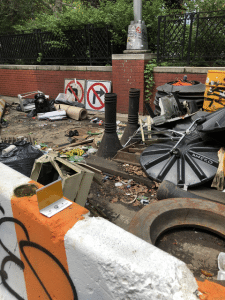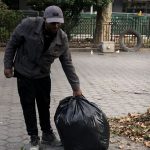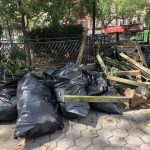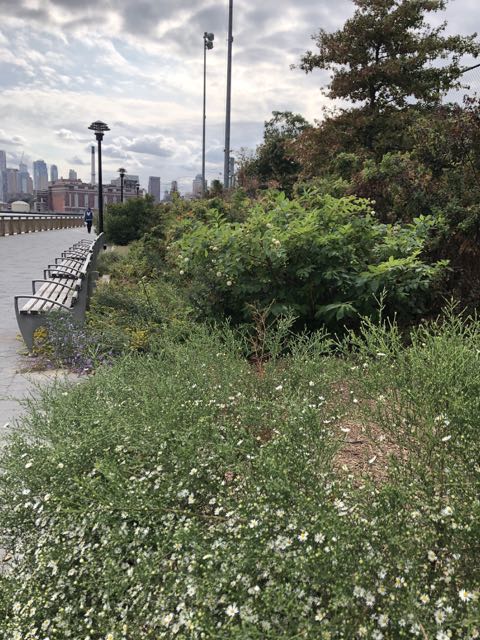Lower East Side Ecology Center Petition To Save The Compost Program
FROM: The Lower East Side Ecology Center Petition:
To Sign Petition: HERE
“Each week, more than 3,500 households depend on LES Ecology Center’s compost program, which began on the Lower East Side in 1990 and is centered at the East River Compost Yard. We offer ten drop-off sites for food scraps, prevent hundreds of tons of organic material from entering landfill every year, and have been introducing countless New Yorkers to the benefits of composting. LES Ecology Center collects and composts these scraps at the Compost Yard, reducing truck trips to take the scraps farther away and providing additional opportunities for New Yorkers to learn the full lifecycle of composting. Local community gardens, schools, and block associations caring for street trees rely on our finished compost to help their plants thrive. The Compost Yard is at the heart of our local environment.
Now, the City is seeking a construction contract to destroy the East River Compost Yard and create a temporary lawn in its place. Not only will this cut off New Yorkers from composting and effectively kill our community compost program, but it will also be a tremendous waste of taxpayer dollars that the City is trying to hide. The plan is moving ahead without any community input and was not even publicly announced at recent community board meetings.
If you support composting, please let the City know how you feel. We demand that the Compost Yard stay operational until the 2023 reconstruction for this section of the Park actually starts. We also demand that the City engage with the LES Ecology Center to finish the design for the renovated Compost Yard as part of the ESCR.”
Contact:
Mayor Bill de Blasio: BDeBlasio@cityhall.nyc.gov
Council Member Carlina Rivera: District2@council.nyc.gov
Parks Commissioner Mitchell Silver:
https://www1.nyc.gov/assets/home/mail/html/maildpr.html
Department of Design and Construction Commissioner Lorraine Grillo:
https://www1.nyc.gov/site/ddc/about/contact-form.page?recipient=Lorraine%20Grillo
Lower East Side Ecology Center Compost Yard Replaced by Passive Lawn?
From Green Map System:
LESEC’s Community Compost program processes food waste from over 3,500 households each week; 150 of these drop off food waste directly at the East River Park compost yard. The plan to move the compost yard to Harlem will directly affect these households, and will uncouple the compost operation from the Ecology Center’s vitally important and very popular educational programs, which will remain on the Lower East Side.
LESEC’s yard in East River Park raises the perceived value of composting, plus it minimizes vehicle miles traveled from drop off sites, further reducing GHGs and overheating. It produces healthy soil that will otherwise need to be procured and trucked in (generating even more VMT and GHGs). In 2019, LESEC’s finished compost augmented the soil in 20 local parks.
To minimize disruption to this important grass-roots community organization, the compost yard must stay operational until construction for this part of the Park, slated for 2023, begins. Furthermore, the City must engage with LESEC to finish the design for the renovated compost yard as part of the ESCR construction as it will yield high quality compost and soil critical to the vitality of East River Park’s new vegetation and restoring habitat for thriving biodiversity.
Raising public interest in composting has not been easy, especially on the Lower East Side where there are few residences with curbside collection containers. What LESEC has established is authentic community climate participation and an accessible, everyday mitigation action. Keeping it in the park has been a universal demand and accommodating LESEC is listed in your public presentations. ..public awareness of this plan occurred only recently, during the holiday season.
Transparency, engagement and resiliency go out the window with this surprise, ill-conceived plan. True mitigation would ensure LESEC’s compost yard is supported in East River Park. ..at minimal expense, Pier 36 can provide peaceful riverside recreation and relaxation space..It’s remarkable you have not made this pier more accessible to the whole community along with the new Eco Park at Pier 35. I have had to bring this up at multiple CB3 Parks committee meetings and have discussed it with Wil Fisher of EDC, without a satisfactory response.
Delivering food scraps to a composting site is a gateway to impact-reducing habits. It’s wrong to tell New Yorkers their mindful actions don’t matter and to make a mockery of this scientifically proven practice of reducing NYC’s solid waste crisis. In addition to making NYC’s ZERO WASTE and 80 x 50 goals less attainable, replacing the compost yard with a lawn will diminish NYC’s standing on the C40, UN 2030 Goals, Climate Emergency and all other international standards.
I urge all the elected and appointed officials.. to stand with me and prevent this grave climate folly.
Sincerely,
Wendy Brawer
Sustainability designer, LES resident and Director, Green Map System
And More Rat Celebrations:
From Chinatown Partnership and Chinatown BID:
Save the Date: Lunar New Year
Saturday January 25 2020
11:00 am Sara Roosevelt Park at Grand Street
|
2020 is the year of the Metal Rat, starting from January 25th, 2020 to February 11th, 2021. The Year of the Rat is the first zodiac sign in the Chinese zodiac cycle. Rats are quick-witted, resourceful, and smart but lack courage. With rich imaginations and sharp observations, they can take advantage of various opportunities well. In Chinese culture, rats represent working diligently and thriftiness, so people born in a Rat year are thought to be wealthy and prosperous. |
Rat Roundtable Discussion of the Plants and Pests of Sara D Roosevelt Park
From The Hort (Horticultural Society of NYC):
A Roundtable Discussion of the Plants and Pests of Sara D Roosevelt Park
Happy 2020! REGISTER FOR THE RAT ROUNDTABLE!
There is room for only 50 people, so register TODAY!
Date And Time
Tue, February 4, 2020
1:00 PM – 3:00 PM EST
Location
88 Essex St
Between Delancey and Broome Streets
Mezzanine Event Space–2nd Floor
New York, NY 10002
Join us for lectures and a roundtable discussion of the
Plants and Pests of Sara D. Roosevelt Park
1:00pm lectures followed by panel discussion
Light refreshments provided and all participants will recieve a $2 Essex Market coupon
Learn current practices in SDR Park and hear from:
- Jamil Phillips, District 3 Park Manager, New York City Department of Parks
- Caroline Bragdon, Director of Neighborhood Interventions, Bureau of Veterinary and Pest Control Services New York City Department of Health and Mental Hygiene
- Pamela Ito, Director of Education, The Horticultural Society of New York
This program is supported, in part, by public funds from the New York City Department of Youth and Community Development in partnership with New York City Council Member Margaret Chin.
The Consequences of New York City’s Recycling Failure
“At the Lower East Side Ecology Center, an acre of land that sits between the FDR Drive and the East River, some 3,500 people drop eight tons of food scraps in a communal container every week.”
Wasted Potential: the consequences of NYC’s recycling failure
Politico: Sally Goldenberg and Danielle Muoio
“Businesses, stores and restaurants, which are part of a separate, loosely regulated system of commercial trash, recycle only 24 percent of the 3 million-plus tons of trash they produce each year, according to a recent report on the industry. A sweeping city law passed last year aims to change that.
Meanwhile, the city’s construction and demolition industry, which produced 6.4 million tons of garbage last year, according to a state official, recycles half the time.
The result: Year after year, New Yorkers rely on rail, barge and trucks to ship trash to methane-producing landfills and toxin-emitting incinerators. The total haul cost the city $409 million last year, a price tag that ballooned after City Hall reformed its waste management system in 2006.”
Read on here.
Let’s not be a city that is taking a front line position on the climate crisis in name only?
DeCarbonizing “We don’t need a miracle. Everything we need to solve climate change is already here”
“We don’t need a miracle. Everything we need to solve climate change is already here.”
How do we decarbonize?
Summary (2-minute read)
How to decarbonize appears to still be a contentious issue, whereas if we move past the “this, not that” arguments that plague the politics of the carbon transition, reasonable thinking leads to an approach that doesn’t require magical thinking or an over-commitment to any single technology. We don’t need a miracle technology — all we really need to do is to commit to massive electrification. Vested interests, however, want you to continue to believe in miracles because it means we can lean back and wait for the miracle to happen.
The actual miracle is that solar and wind are now the cheapest energy sources, electric cars are better cars than those we already have, electric radiant heating is better than our existing heating systems, and the internet was a practice run and blueprint for the electricity network of the future. Regardless of the minutiae of how we do it exactly, the beginning and the first half of decarbonization will most likely look the same: a commitment to solar and wind, batteries, electrification of homes, heat pumps, electric vehicles, ground-source geothermal and research into better biofuel sources and biofuels from waste, as well as research into better, cheaper, safer nuclear.
A carbon tax isn’t a solution; at best it will just accelerate solutions. It’s likely that un-subsidizing fossil fuels will be just as effective. By the time we have the political stomach for a carbon tax, the cheapest solutions will be electric vehicles, electrified homes, and wind and solar anyway.
We haven’t shown any inclination to drastically cut our consumption in the 40 years since Jimmy Carter asked us to wear sweaters.
Efficiency is great, but, like a carbon tax, it still isn’t a solution. Overwhelmingly, the largest efficiency wins aren’t LED lighting, double-glazed windows and heavier building insulation (each which is good but not nearly enough), but rather the electrification of cars and trucks, the electrification of our homes, and eliminating thermo-electric losses from the burning of fossil fuels to create electricity.
Nuclear power vs. renewables doesn’t become an issue during the first half of the transition to mass electrification, and by then nuclear might be too expensive (compared to wind and solar).
Coal or natural gas with carbon sequestration is expensive and won’t scale to the size of the problem. We know fracking leaks and that sequestered CO2 will leak too. The mere fact that compressed CO2 is much larger by volume than the oil and gas that come out tells us the simple story that we don’t have enough holes to stuff it into. Additionally and specifically, natural gas is a bridge to nowhere; fossil fuels already burned that bridge.
Renewables are disrupting fossil fuels, and if the US does not win that technology game it will no longer be the leading world power. No one is looking forward to that existential crisis.”
From the NYTimes: “The World Solved the Ozone Problem. It Can Solve Climate Change”
“ nothing is lost until it has been abandoned”
– Goethe
Are there reasons to hope for serious action?
“The prospect of thousands and even millions of cancer deaths led to the Montreal Protocol. The Cuyahoga River catching on fire, giant algae blooms in lakes and rivers, and widespread contamination of municipal water supplies led to the Clean Water Act of 1972. Oppressive inner-city smog — so bad you could nearly taste it — as well as mounting respiratory illnesses, and dead and dying trees, streams and lakes, helped overcome political and industry foot-dragging and created the landmark 1990 amendments to the Clean Air Act and its innovative cap-and-trade system for controlling ground-level pollutants.”
“In addition, there were no relatively expeditious technological fixes for carbon emissions, as there were for fluorocarbons, and as there were for the pollutants addressed in the 1990 Clean Air Act Amendments, like scrubbers for power plants, and catalytic converters and cleaner fuels for cars and light trucks. The global warming problem requires a whole suite of fixes, some of them mammoth, as Mr. Moynihan intuited a half-century ago — carbon-free alternatives to produce electricity; an all-electric vehicle fleet; an end to deforestation; climate-friendly agricultural practices; large-scale dietary changes; and, quite possibly, advanced technologies to draw carbon dioxide out of the atmosphere. Reimagining the world economy means turning around a very big ship. Not to mention global buy-in”.
“Finally, despite predictable industry warnings of economic ruin, the efforts to protect the ozone layer and clean up the nation’s waters and air faced nowhere near the campaign of denial and disinformation mounted by Exxon Mobil and other big fossil fuel companies — companies that knew perfectly well what their products were doing to the atmosphere — to confuse the public about climate change and to derail serious attempts to address them. This cascade of phony science was not the only reason legislation aimed at reducing carbon pollution foundered in Congress. As Bill Clinton and Mr. Gore discovered after signing the Kyoto Protocol in 1997, there was little enthusiasm in either party for a treaty that essentially required America and other industrial nations to do most of the heavy lifting while giving other big emitters, among them China and India, a far easier path. Still, industry’s relentless obfuscation played a big role, especially among Tea Party Republicans.”
In answer to: Is there hope?
“Yes: a trifecta of frightening reports in the last year from the Intergovernmental Panel on Climate Change on the need to act before things spin out of control, on deforestation and other damaging land-use practices, on dying reefs and rising sea levels. Plus: a cascade of natural disasters, including catastrophic wildfires and hurricanes. Plus: the dramatic drop in the cost of producing carbon-free energy like wind and solar power. Plus: well-publicized concerns on the part of every contender for the Democratic presidential nomination, and equally well-publicized efforts by state and local officials, to fill the global leadership vacuum left by President Trump.”
Growing numbers of People in the U.S. Describe Climate Change as a Crisis

A growing number of Americans describe climate change as a crisis. 2/3’s say President Trump is doing too little to tackle the problem.
From a poll conducted by The Washington Post and Kaiser Family Foundation:
“a growing disconnect between Americans worried about the warming planet and Trump administration officials who aggressively scaled back Obama-era environmental regulations and relinquished the nation’s role as a global leader in pushing for climate action.”
“A strong majority of Americans, about 8 in 10, say human activity is fueling climate change, and roughly 1/2 believe action is urgently needed within the next decade if humanity is to avert its worst effects.
Nearly 4 in 10 now say climate change is a crisis, up from less than a quarter five years ago.
Goldman Sachs Announces It Will Stop Financing Arctic Oil
From The Sierra Club:
“Drilling in the Arctic Refuge would permanently destroy the primary food source of the Gwich’in people, our culture, and our way of life,” Bernadette Demientieff, executive director of the Gwich’in Steering Committee, said in a statement. “We’re glad to see Goldman Sachs recognize that the Arctic Refuge is no place for drilling, and we hope that other banks, and the oil companies they fund, will follow their lead.”
The new lending policy is a win for environmentalists in the fight to preserve the 1.5 million acres of land on the coastal plains of the Arctic National Wildlife Refuge, which the Trump administration proposed opening for drilling in 2017. Since then, the administration has been working to expedite the environmental review process in order to meet its goal of holding a lease sale in the refuge this year, but in November, the Interior Department announced that it would miss this target.
“the scientific consensus, led by the Intergovernmental Panel on Climate Change, that climate change is a reality and that human activities are responsible for increasing concentrations of greenhouse gases in the earth’s atmosphere.”
“we need to focus our efforts on the other US funders that are notorious for propping up dirty fuels: Wells Fargo, Citi, JP Morgan Chase, Bank of America, and Morgan Stanley.
Send a message to the CEOs of the other major US banks, telling them that bankrolling Arctic drilling isn’t just bad business — it’s a threat to Indigenous human rights and to the climate.“
Small steps add up.
- Go to the previous page
- 1
- …
- 46
- 47
- 48
- 49
- 50
- 51
- 52
- …
- 164
- Go to the next page

















